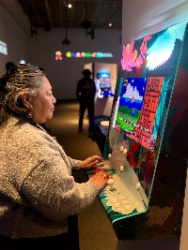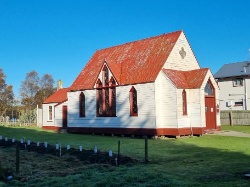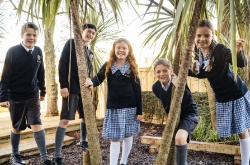Landmark Tongan Exhibition Opens At Te Whare Toi O Heretaunga
This weekend Te Whare Toi o Heretaunga Hastings Art Gallery opens a celebration of traditional Tongan artforms reimagined through a contemporary art lens by two celebrated Tongan artists – Dagmar Vaikalafi Dyck and Sopolemalama Filipe Tohi.

’Amui ’i Mu’a: Ancient Futures (installation view) at Te Whare Toi o Heretaunga – Hastings Art Gallery. One of the Hawke’s Bay Museum Trust Collection ngatu can be seen in the background, on the pink wall, with works by Tohi and Dyck in the foreground. Photo/SUPPLIED
First exhibited in Auckland in 2021, ‘Amui ‘i mu’a – Ancient Futures is the culmination of a four-year research project, which saw the pair travelling the world to view traditional 18th and 19th Century Tongan artefacts in museum collections in Australia, United States, United Kingdom, France, Austria, Germany, Sweden, and New Zealand.
The pair are excited to bring the exhibition to Heretaunga-Hastings and hope local Tongan and wider Moana-Nui-a-Kiwa communities will connect with their work, which includes responses to ngatu, Tongan barkcloth, alongside other traditional artforms.
Included in the exhibition are three 20th Century ngatu, from the Hawke’s Bay Museum Trust Collections. One of these ngatu references Queen Elizabeth II, a sign of how ngatu are used within the Tongan community, Dyck says.
“Ngatu has always mirrored the times in which the maker is making – it’s about recording history, recording narratives and stories.”
Tohi, who was born in Tonga and has been described as ‘Tongan art’s foremost ambassador’, says that seeing traditional artefacts in person connected him to his Tongan identity in a more palpable way.
“It gave me a chance to look more in depth into the more traditional Tongan approach. And, at the same time, it was a learning thing to be able to look at all the Tongan objects, we call it koloa, because you don’t usually have a chance to look at that kind of traditional [practice],” he says.
“It’s like [connecting with your] tūrangawaewae… to be able to look at some of the works around the world, it keeps you stronger and more grounded.”
Dyck was the first New Zealand woman of Tongan descent to complete a Bachelor of Fine Arts and a Postgraduate Diploma of Arts, from Elam School of Fine Arts in Tāmaki Makaurau Auckland.
“I’ve been looking at these objects all my life. So, it’s an ongoing opportunity to delve deeper and actually be physically in contact with these objects. That was the privileged part of our position – actually being able to be physically in the same space as them, given that most of them are offshore,” she says.
“It’s spiritual, it’s emotional, it ticks all those things - because for many of the objects that we were in contact with, a lot of them aren’t being made anymore, or we’ve lost the knowledge around their origins and their purpose. That was the beauty of the conversations about what they are used for.”
But Dyck is quick to point out that she and Tohi do not consider themselves experts in these objects. “We know that within our communities there are knowledge-holders who would have insights into that – so the more of our community that can see [this project], they will be able to offer those insights into it as well.”
In that regard, ’Amui ’i Mu’a: Ancient Futures does not represent a single moment in time, or a completed piece of work by these two highly-regarded Tongan artists. Instead, this exhibition and the work within it represents an ongoing conversation, a talanoa, between the artists and their communities, ancestors, and artforms, and with the important knowledge held within them all.
“This is a reciprocal way of working and collaborating together. It’s not finished, this is just an ongoing conversation. It’s not like this project has ‘arrived’. We continue to push and pursue, and that comes through meeting new people in our communities who will add to the conversation,” she says.
While Dyck and Tohi have known each other for years, this is the first time the pair have worked alongside each other on a shared project. Each artist responded to different works from the overseas collections, yet in a way which is both complementary and balanced.
Dyck says it was a strategic decision to have a male and female artist on the project, as it ensures a broader, more balanced approach.
“We held interests across all the things we saw but [were drawn to] certain aspects – for me, the textiles and more feminine forms, and for him the more masculine, which you can see with his sculptures,” Dyck says.
“It mirrors the societal structures that we work in. But there’s also the fact that Filipe’s Tongan-born, I’m New Zealand-born of mixed heritage, so there’s different lenses and different ways that we work, which you can see in elements of mine - which are more Western materials - whereas Filipe’s works are more in keeping with natural or traditional materials.”
Tohi agrees the gender-balanced approach echoes Tongan society, saying men and women traditionally have different roles in Tonga, but always work together.
“In Tonga, women make the mats, and men do the carving, so if I go [on a research trip] by myself it’s a different kind of approach. With women around we see all kinds of things, it’s better… to be able to have a woman like Dagmar be part of it, doing the research, it makes you understand that it’s not just a carving that you’re looking at,” Tohi says.
“From a traditional point of view, women and men have their own work, but they work together, alongside each other. The Pacific, and the Tongans, always have a duality in a way… The soft and the hard, the female and male – because Tongans always have two working together. It’s community work, it’s family work.”
- Te Whare Toi o Heretaunga – Hastings Art Gallery is open from 10am till 4.30pm, Monday to Saturday, and from 1pm till 4pm on Sundays.


 Tūhura Otago Museum: South Island Levels Up With Toi Māori-Inspired Arcade Art At Tūhura
Tūhura Otago Museum: South Island Levels Up With Toi Māori-Inspired Arcade Art At Tūhura NZSTA: Campaign Launched To Boost School Board Participation
NZSTA: Campaign Launched To Boost School Board Participation Heritage New Zealand: Kakanui Church Listed As Category 1 Historic Place
Heritage New Zealand: Kakanui Church Listed As Category 1 Historic Place NZ College of Public Health Medicine: College Supports Calls For Stronger Regulation To Address Campylobacter Epidemic
NZ College of Public Health Medicine: College Supports Calls For Stronger Regulation To Address Campylobacter Epidemic Ngā Pae o te Māramanga (NPM): Higher Education Improves Outcomes For Māori And Pacific People
Ngā Pae o te Māramanga (NPM): Higher Education Improves Outcomes For Māori And Pacific People The Charter School Agency: Eighth Charter School Opens In Auckland
The Charter School Agency: Eighth Charter School Opens In Auckland